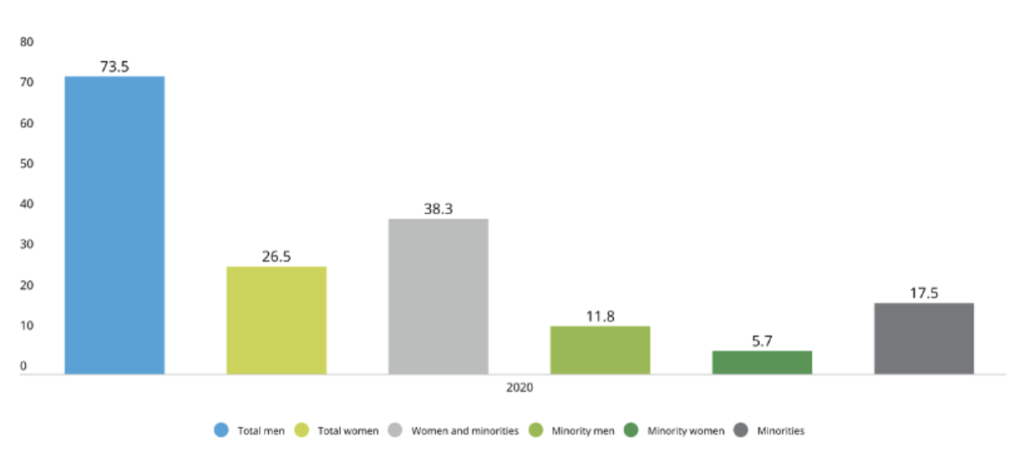On August 6, The Securities and Exchange Commission (SEC) provided initial approval of a Nasdaq proposal that aims to get more women and minorities on the boards of companies trading on the stock exchange. This endorsement by the SEC will be a huge step toward encouraging more diversity and inclusion across industries and will set a precedent for organizations around the world.
Nasdaq’s proposal will require companies to have at least one female board member and at least one board member that represents a minority community or provide a reason why it’s not possible, and would be enforced within four years of the SEC’s endorsement.
We’ve known for a while that companies with more diverse executives are 33% more likely to see above-average profits. So, why aren’t our corporate boards reflecting this as well now? Institutionally mandated or not, public companies shouldn’t want a group of people that all look, think, act, dress and talk the same making decisions for their long-term future. A unique mix of smart and dedicated people bring with them new and fresh perspectives, which I believe is critical to staying competitive in any industry, most certainly in tech.
The Case for Visibility
Attracting capable people requires a commitment to showing—literally, showing—them that they have a valuable seat at the table. It is far more feasible for young talent to visualize themselves in positions of leadership if they can physically see someone like them in that same role. It’s human nature to want to replicate people we admire, so by placing a wider spread of representatives on corporate boards, we’re not just creating diversity as a lip service, we’re letting women and minorities know that the odds aren’t as stacked against them as they’ve been led to believe. Even in areas outside of tech, there are valuable examples of why “seeing is believing” in terms of professional aspirations.
Consider this: Even the most decorated gymnast in history, Simone Biles, needed a role model. On her road to the Olympics, Simone competed in a sport that was dominated primarily by white and Asian athletes. But it was when she saw Gabby Douglas—a competitor that finally looked like her on the tumbling mat—dominate at the 2012 Summer Games that she said she gained the confidence it took to compete at that level. Even through the trials and “twisties” Simone faced at the recent Games, she remains a role model for other aspiring athletes - and an advocate for mental health and well being.
Simon Biles shares a lot of similarities with Microsoft and IBM veteran John W. Thompson, venture partner at Lightspeed Venture Partners. Thompson was the first Black salesperson for IBM in Tampa, Florida back in the early ‘70s. He says he was sitting in a meeting early in his career, looking around at the other leaders in the room, and realizing he too could work his way up to CEO. Alas, seeing is believing. For him and Simone alike, “seeing” was the deciding factor that sparked a new level of confidence within.
The State of Corporate Board Diversity
There is a phenomenal multiyear study organized by the Alliance for Board Diversity (ABD), in collaboration with Deloitte, that’s been released in 2016, 2018 and 2020, and the results are telling. The most recent edition highlights the progress to date that has or has not been made in the equitable representation of women and minorities on corporate boards.

The chart above displays the percentage of board seats by gender and minority status in Fortune 500 companies. While the study found that white women have gained 21% of board seats in the Fortune 500, it’s the only group in the study that improved its representation. The numbers are an improvement from 2018, but there’s still a lot of ground to cover. Hispanics/Latinos make up 18.5% of the population but fill just 4.1% of board seats in Fortune 500. Black individuals represent 13.4% of the population but hold just 8.7% of Fortune 500 board seats.
Visibility Above Everything Else
In order to see more Simones and Johns—bright, ambitious and inclusive individuals—in company board leadership roles, we need said groups to reflect the diversity of the modern workforce. CEOs, CMOs, CFOs of different races, genders, sexual orientations and cultural backgrounds need to be seen holding valuable positions in corporate America. The more often this happens, the more easily young talent can visualize themselves someday achieving similar success.
Bottom line: If companies want ambitious and smart people working for, advising and representing them, they cannot sleep on the importance of diversity on company boards. Take note of Simone’s and John’s stories. Young, bright employees right under our noses that just need a glimpse of attainability to realize that they can make it, too. But without diversity on company boards and other leadership roles, young talent can easily turn into discouraged, untapped potential.
A “case study,” if you will, on the power of diversity in company leadership comes from tech entrepreneur Theresia Gouw. She is a first-generation immigrant from Indonesia that is the epitome of the American dream. She worked at a Burger King in high school before she attended Brown University (on scholarships and a second mortgage on her parent’s home). She graduated magna cum laude with an engineering degree in 1990 and holds an M.B.A. from Stanford Graduate School of Business, where she co-teaches a course on venture capital.
For years, Theresia has been a driving force for encouraging smart and distinguished women to excel in their tech careers and has promoted many women to serve on boards themselves. Her passion for educational causes and increasing diversity in the tech industry has had a ripple effect across our industry. She has a reputation of helping other women rise up, and I know that her visible success has inspired other young minority women to achieve great things.
Seeking New Avenues for Board Candidates
The ABD/Deloitte study referenced above found that nearly 36% of diverse board seats are occupied by persons on multiple Fortune 500 boards. This tells us there is an overreliance on “the same” diverse board members and that the opportunities need to be spread more widely among eligible women and minority board candidates. Companies should be seeking out new talent networks in order to diversify their boards in the most impactful way—not just placing the same diverse candidate again, and again, and again.
To help diversify corporate boards, several new initiatives on top of the work at the SEC have emerged. Namely, The Black Boardroom Initiative, which helps pair candidates with companies seeking directors. Launched by Seattle’s Perkins Coie, the initiative’s goal is to increase the diversity of S&P 500 corporate boards by training cohorts of potential candidates. The law firm set a goal of 12.5% Black directors in Washington by 2028, which would match the ratio of Black people in the state.
Another initiative—with which I am proud to be involved personally—is FirstBoard.io. This curated group of accomplished female executives in technology is working together to increase the representation of women on boards and at the highest level of corporate governance and management. I love seeing the things FirstBoard.io is doing in Silicon Valley and beyond in terms of making corporate diversity a reality and giving women an opportunity for their first seat at the board table.
These programs aren’t just virtuous; they’re helping meet the increased legal requirements for diversity on public boards as showcased in the recent Nasdaq proposal. States like California and Illinois are leading the way in this effort. Publicly held companies headquartered in California are now required to include board members from underrepresented communities, per a bill passed by Governor Newsome in September 2020. In 2019, Illinois’ Governor signed legislation that would mandate an annual report on the gender, racial and ethnic diversity on the corporate boards of Illinois’ publicly traded companies, including how they identify and appoint diverse candidates to their boards.
Let’s create more opportunities for women and minorities to be seen on corporate boards. It’s exciting that institutions like the SEC and Nasdaq are taking notice of the benefits of the unique insight and expertise different types of people can bring to the board room—I predict this is just the start of something great. Let’s just not wait four years to make it happen.



